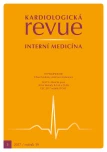Infective Endocarditis
Authors:
M. Tesák 1,2; J. Pařenica 1,3; E. Míšková 2
Authors‘ workplace:
Interní kardiologická klinika FN Brno
1; Interní oddělení, Nemocnice Třebíč
2; Lékařská fakulta MU Brno
3
Published in:
Kardiol Rev Int Med 2017, 19(3): 177-182
Overview
Infective endocarditis is an inflammatory heart disease which affects the endocardium, as well as artificial prosthetic materials within the heart cavities. The disease remains one of the most serious infectious diseases due to changes in its clinical course and microbial etiology in an era which has seen an increase in the use of artificial implants. Classifying infective endocarditis according to the type of condition and epidemiology factors is important for the correct choice of initial empirical treatment and subsequent treatment strategy. A targeted antibiotic regimen is then determined on the basis of identification of the causative agent. The most frequent agents affecting the endocardium include Staphylococcus aureus and the viridans streptococci. The diagnosis of infective endocarditis is based on microbiological findings, along with imaging methods, especially echocardiography, which demonstrate the presence of the infection within the heart cavities. The treatment of infective endocarditis requires a comprehensive approach in close interdisciplinary collaboration and should be provided in cooperation with Endocarditis Teams in specialised centres. The prevention of infective endocarditis includes basic sanitary measures applied across the whole population to prevent bacteraemia combined with antibiotic prophylaxis administered in a small group of high-risk individuals.
Keywords:
endocarditis – valve disease – echocardiography – infection
Sources
1. Leone S, Ravasio V, Durante-Mangoni E et al. Epidemiology, characteristics, and outcome of infective endocarditis in Italy: the Italian Study on Endocarditis. Infection 2012; 40(5): 527– 535. doi: 10.1007/ s15010-012-0285-y.
2. Baddour LM, Bettmann MA, Bolger AF et al. Nonvalvular cardiovascular device– related infections. Circulation 2003; 108(16): 2015– 2031. doi: 10.1161/ 01.CIR.0000093201.57771.47.
3. Nery PB, Fernandes R, Nair GM et al. Device-related infection among patients with pace-makers and implantable defibrillators: incidence, risk factors, and consequences. J Cardiovasc Electrophysiol 2010; 21(7): 786– 790. doi: 10.1111/ j.1540-8167.2009.01690.x.
4. Habib G, Lancellotti P, Antunes MJ et al. 2015 ESC Guidelines for the management of infective endocarditis. The Task Force for the Management of Infective Endocarditis of the European Society of Cardiology (ESC)Endorsed by: European Association for Cardio-Thoracic Surgery (EACTS), the European Association of Nuclear Medicine (EANM). Eur Heart J 2015; 36(44): 3075– 3128. doi: 10.1093/ eurheartj/ ehv319.
5. Habib G, Hoen B, Tornos P et al. Guidelines on the prevention, diagnosis, and treatment of infective endocarditis (new version 2009). The Task Force on the Prevention, Diagnosis, and Treatment of Infective Endocarditis of the European Society of Cardiology (ESC). Eur Heart J 2009; 30(19): 2369– 2413. doi: 10.1093/ eurheartj/ ehp285.
6. Li JS, Sexton DJ, Mick N et al. Proposed Modifications to the Duke Criteria for the Diagnosis of Infective Endocarditis. Clin Infect Dis 2000; 30(4): 633– 638. doi: 10.1086/ 313753.
7. Murdoch DR, Corey GR, Hoen B et al. Clinical presentation, etiology, and outcome of infective endocarditis in the 21st century: the International Collaboration on Endocarditis– Prospective Cohort Study. Arch Intern Med 2009; 169(5): 463– 743. doi: 10.1007/ s10096-002-0798-x.
8. Toyoda N, Chikwe J, Itagaki S et al. Population trends in the incidence, etiology and outcomes of infective endocarditis. Circulation 2016; 134 (Suppl 1): Abstract A20605.
9. Beaulieu A, Rehman HU. Janeway lesions. Can Med Assoc J 2010; 182(10): 1075. doi: 10.1503/ cmaj.091528.
10. Mylona E, Samarkos M, Kakalou E et al. Pyogenic vertebral osteomyelitis: a systematic review of clinical characteristics. Semin Arthritis Rheum 2009; 39(1): 10– 17. doi: 10.1016/ j.semarthrit.2008.03.002.
11. Le Moal GL, Roblot F, Paccalin M et al. Clinical and laboratory characteristics of infective endocarditis when associated with spondylodiscitis. Eur J Clin Microbiol Infect Dis 2002; 21(9): 671– 675. doi: 10.1007/ s10096-002-0798-x.
12. Habib G, Derumeaux G, Avierinos JF et al. Value and limitations of the duke criteria for the diagnosis of infective endocarditis. J Am Coll Cardiol 1999; 33(7): 2023– 2029. doi: 10.1016/ S0735-1097(99)00116-3.
13. Bruun NE, Habib G, Thuny F et al. Cardiac imaging in infectious endocarditis. Eur Heart J 2014; 35(10): 624– 632. doi: 10.1093/ eurheartj/ eht274.
14. Pérez-Vázquez A, Fariñas MC, García-Palomo JD et al. Evaluation of the Duke criteria in 93 episodes of prosthetic valve endocarditis: could sensitivity be improved? Arch Intern Med 2000; 160(8): 1185– 1191. doi: 10.1001/ archinte.160.8.1185.
15. Rouzet F, Chequer R, Benali K et al. Respective performance of 18F-FDG PET and radiolabeled leukocyte scintigraphy for the diagnosis of prosthetic valve endocarditis. J Nucl Med 2014; 55(12): 1980– 1985. doi: 10.2967/ jnumed.114.141895.
16. Moter A, Musci M, Schmiedel D. Molecular methods for diagnosis of infective endocarditis. Curr Infect Dis Rep 2010; 12(4): 244– 252. doi: 10.1007/ s11908-010-0111-6.
17. Tesák M. Infekční endokarditida. In: Ševčík P (ed.) Intenzivní medicína. Praha: Galén 2014: 751– 754.
18. Beneš J, Gregor P, Mokráček A. Infekční endokarditida. Doporučené postupy diagnostiky, léčby, dispenzarizace a profylaxe. Cor Vasa 2007; 49(6): Kardio.
19. Kang DH, Kim YJ, Kim SH et al. Early surgery versus conventional treatment for infective endocarditis. N Engl J Med 2012; 366(26): 2466– 2473. doi: 10.1056/ NEJMoa1112843.
20. Piper C, Körfer R, Horstkotte D. Prosthetic valve endocarditis. Heart 2001; 85(5): 590– 593. doi: 10.1136/ heart.85.5.590.
21. Ruttmann E, Willeit J, Ulmer H et al. Neurological outcome of septic cardioembolic stroke after infective endocarditis. Stroke 2006; 37(8): 2094– 2099. doi: 10.1161/ 01.STR.0000229894.28591.3f.
22. Yoshioka D, Sakaguchi T, Yamauchi T et al. Impact of early surgical treatment on postoperative neurologic outcome for active infective endocarditis complicated by cerebral infarction. Ann Thorac Surg 2012; 94(2): 489– 496. doi: 10.1016/ j.athoracsur.2012.04.027.
Labels
Paediatric cardiology Internal medicine Cardiac surgery CardiologyArticle was published in
Cardiology Review

2017 Issue 3
Most read in this issue
- Cardiovascular risk stratification and new serum lipid target levels
- SGLT2 inhibitors (gliflozins) antidiabetics, antihypertensives or drugs for heart failure?
- Statin intolerance – finding practical solutions
- Infective Endocarditis
